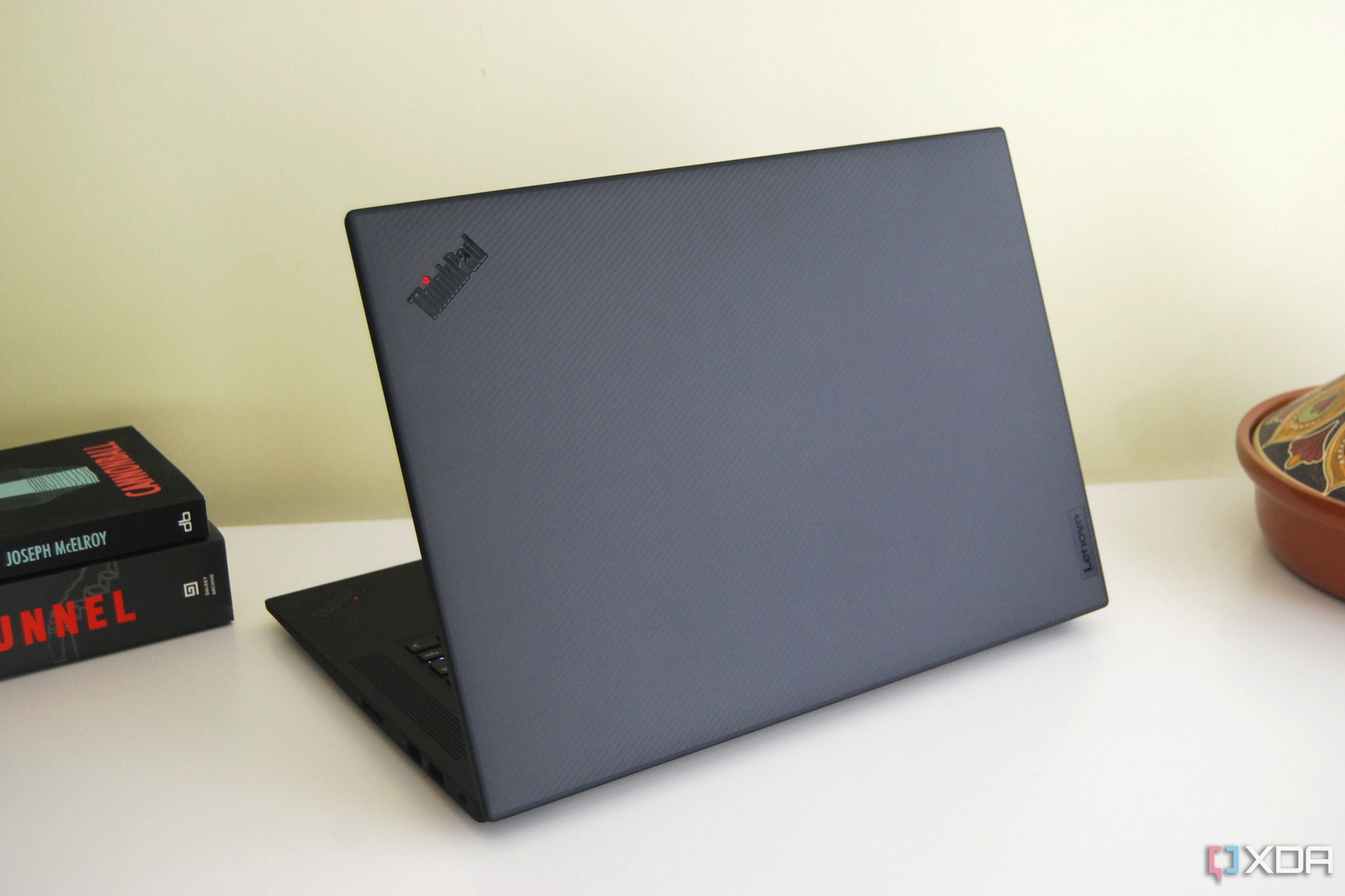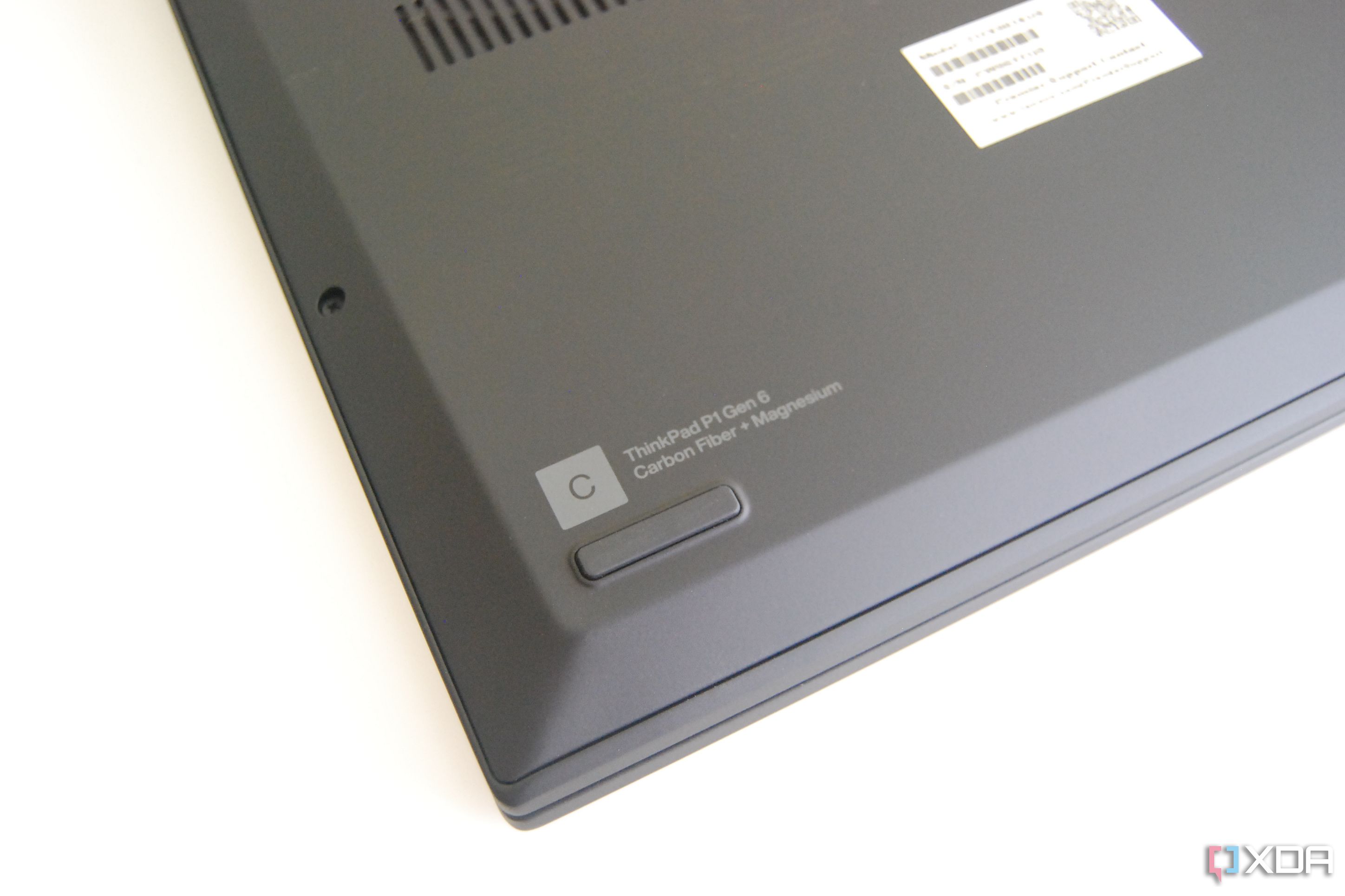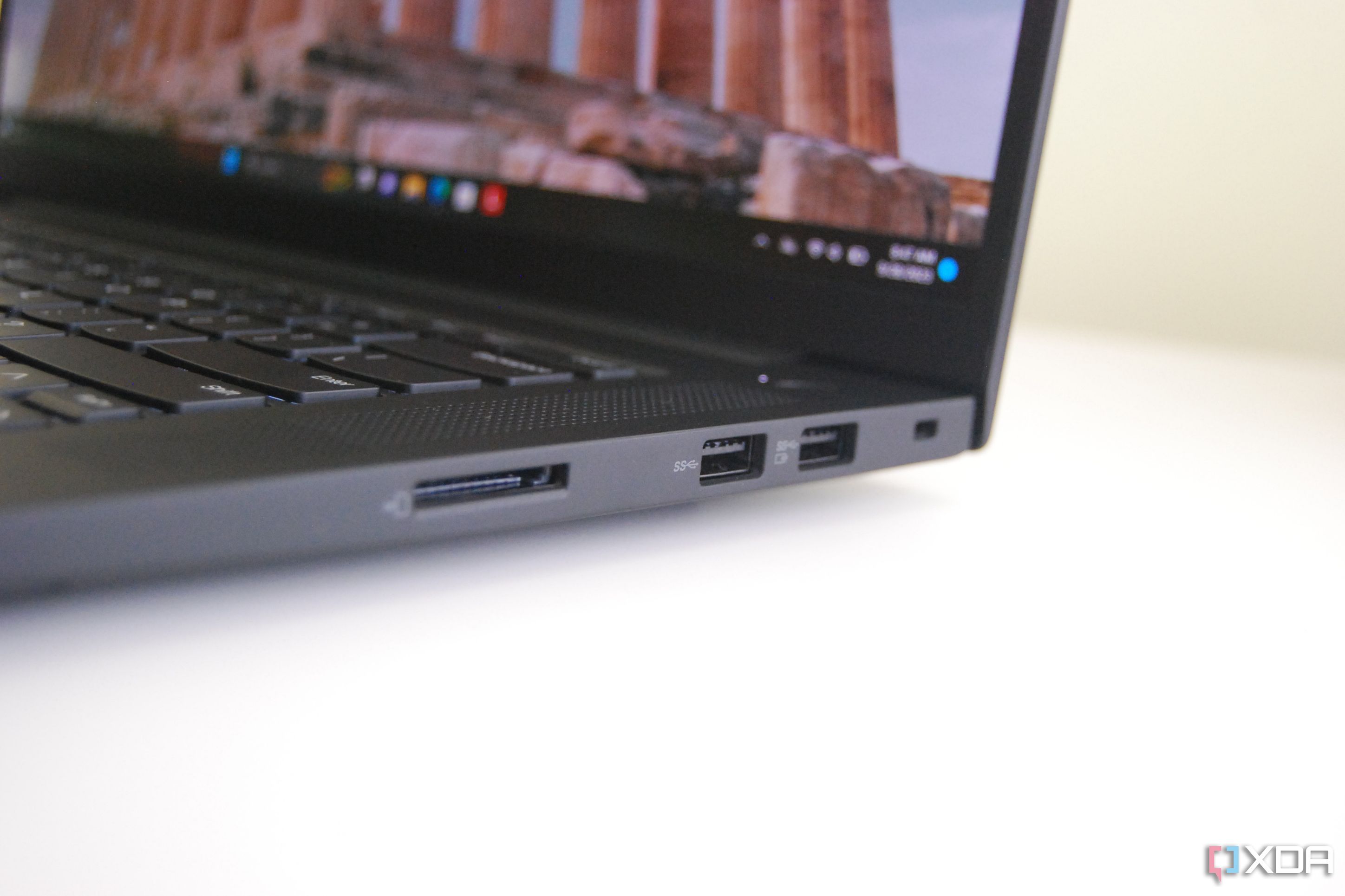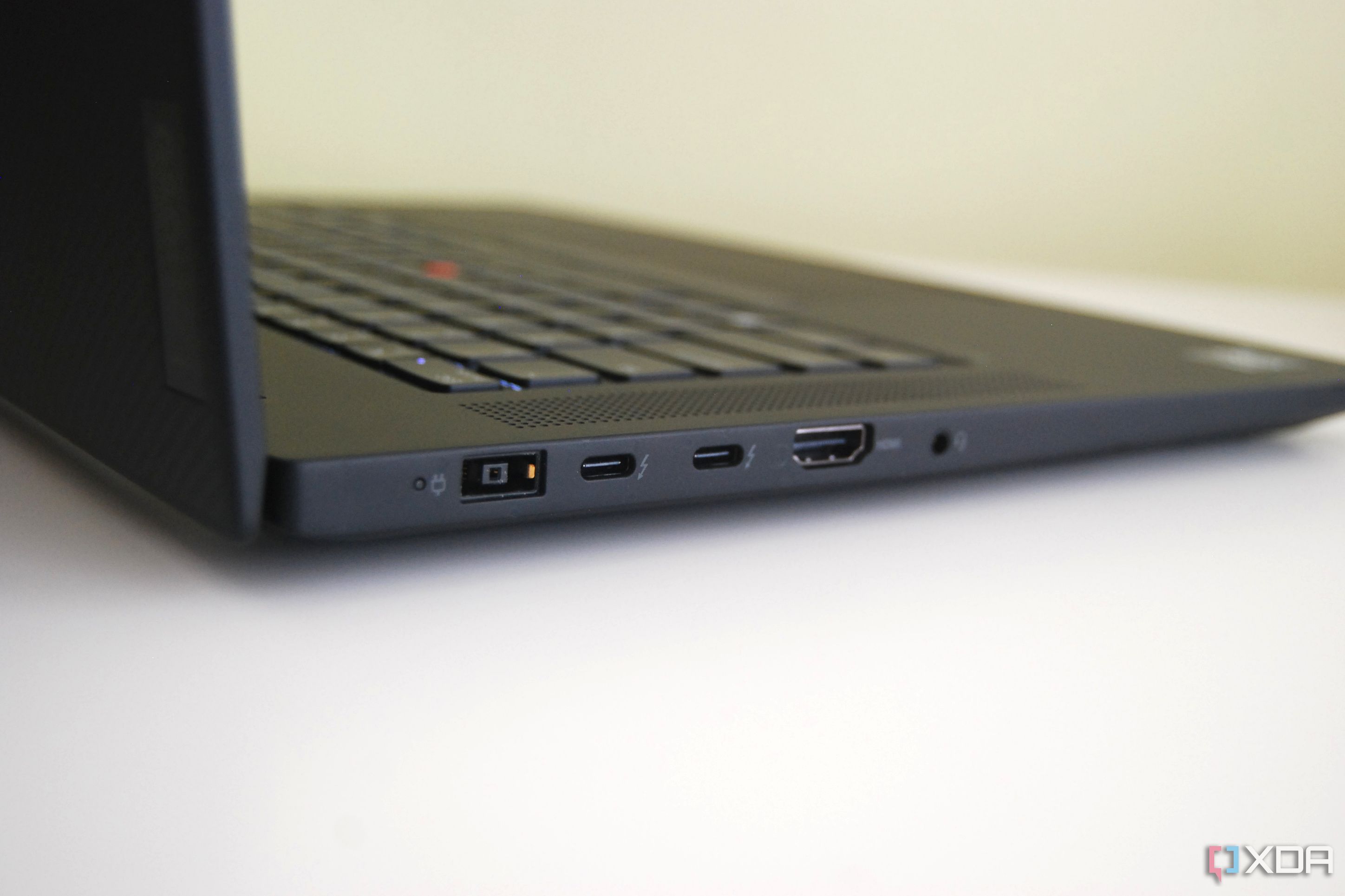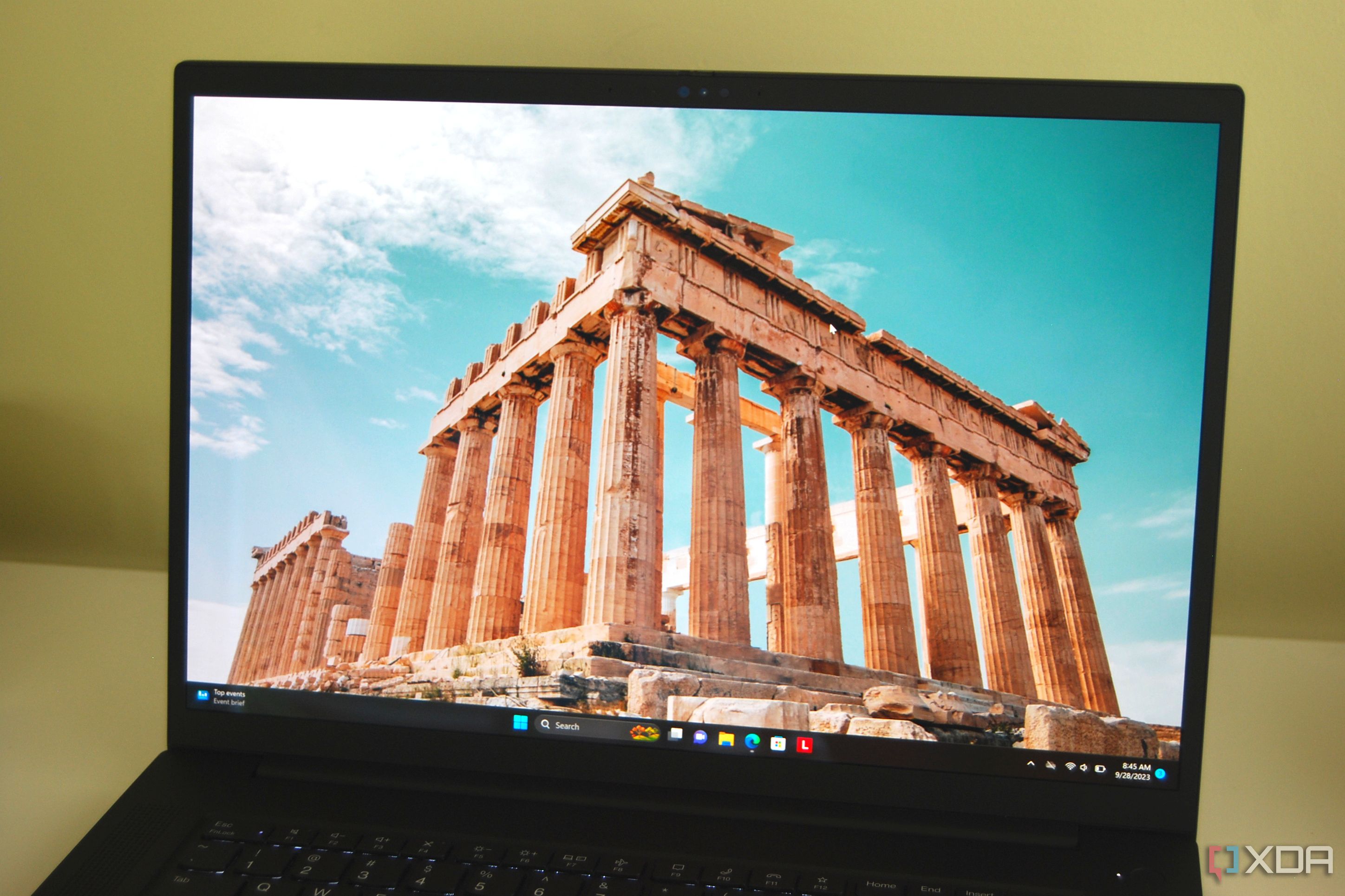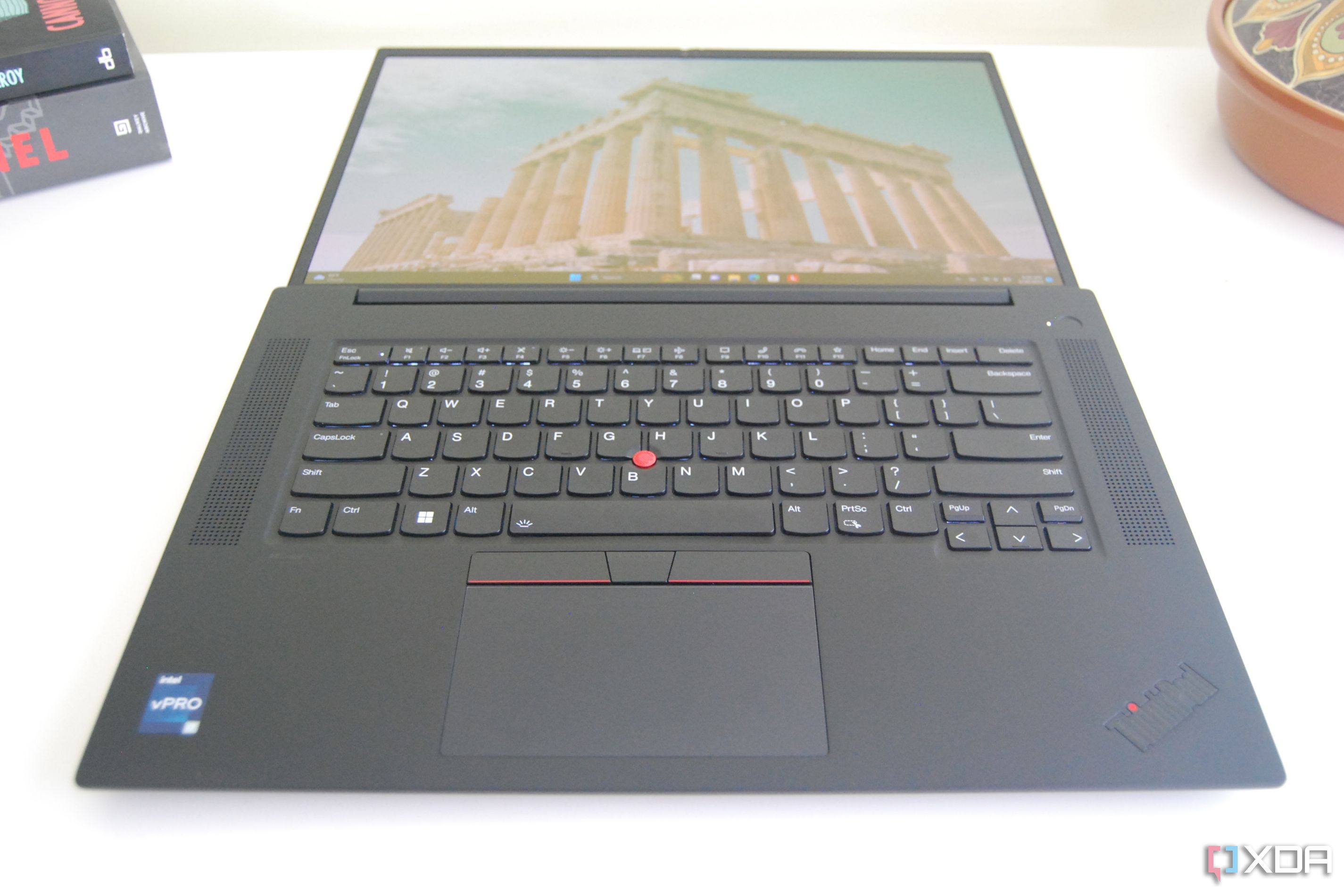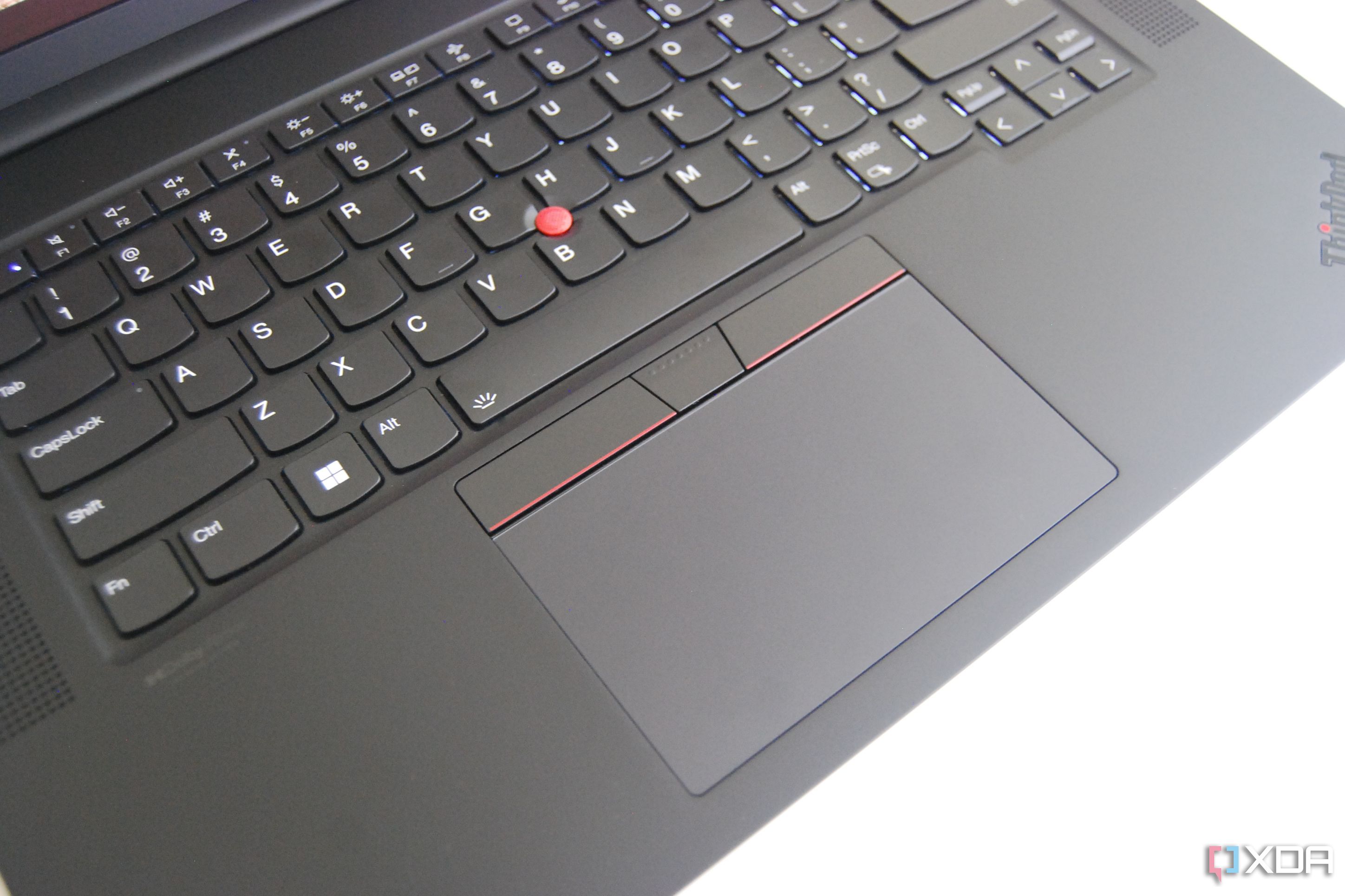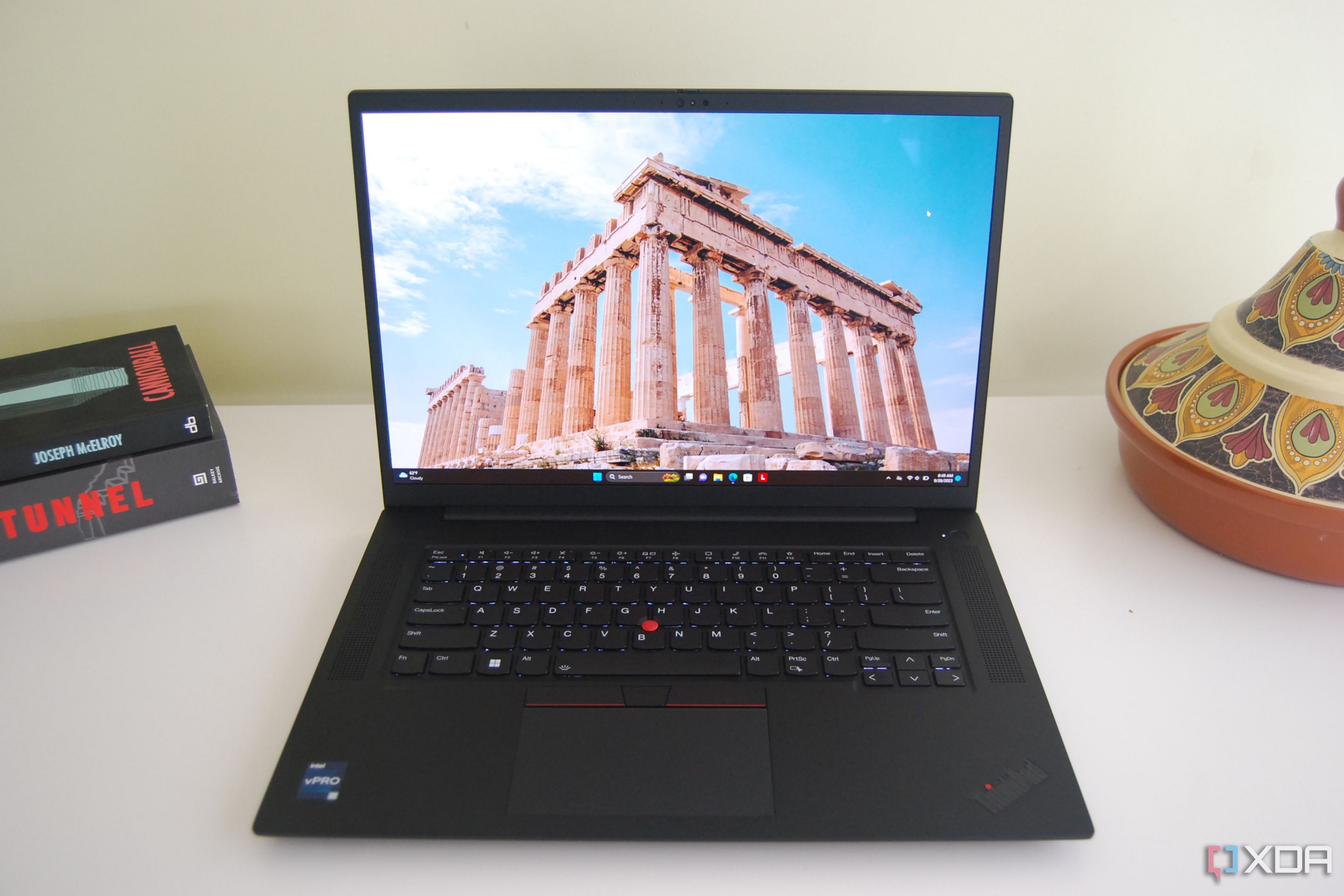The ThinkPad P1, now in its sixth generation, is Lenovo’s answer to professionals who want a proper workstation laptop that sides with mobility rather than all-out performance. It’s surprisingly thin and light for a laptop from this class, and it shares a lot of design DNA with the X1 Extreme (Gen 5) that we reviewed. However, the P1 is available with Ada-class Nvidia discrete GPUs made for specialized work, and it comes with a number of ISV certifications to prove that the top modeling and design software runs optimally on the system. The high asking price is balanced by a suite of high-end features that make for a comfortable user experience, but is it ultimately the best laptop for you?
After spending a couple of weeks with the ThinkPad P1 (Gen 6), I would comfortably recommend it to anyone shopping for a mobile workstation. It’s a more specialized and powerful alternative to the ThinkPad X1 Extreme, and it should pull in plenty of Windows fans as a counterpunch to the MacBook Pro. But there are a few caveats that keep it from being the best option for anybody looking for this kind of device.
About this review: Lenovo supplied XDA with a sixth-gen ThinkPad P1 (2023) for review. Lenovo did not have any input into this article’s contents.
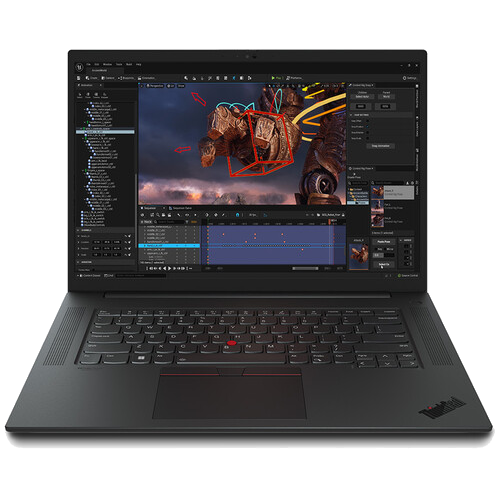
Source: Lenovo

Lenovo ThinkPad P1 (Gen 6)
Big performance, thin build
Mobile workstation that weighs four pounds
$2119 $3649 Save $1530
The ThinkPad P1 (Gen 6) for 2023 sides more with mobility than it does raw performance, and for many professionals that’s exactly what’s needed. It can nevertheless handle intensive tasks, and it does so while also offering many high-end features focused on the privacy and security of the user.
- CPU
- Intel Core i7-13700H, i7-13800H, i7-13900H
- GPU
- Up to Nvidia RTX 4090 Laptop GPU (16GB GDDR6 VRAM)
- RAM
- Up to 96GB DDR5 RAM
- Storage
- Up to 8TB (2x4TB) M.2 PCIe 4.0 NVMe Opal 2.0 SSD
- Battery
- 90Wh
- Display (Size, Resolution)
- 16-inch 1920×1200 IPS, 2560×1600 IPS, 3840×2400 OLED
- Camera
- Hybrid FHD 1080p IR, 5MP IR hybrid, human presence detection, privacy shutter
- Speakers
- Dual 2W with Dolby Atmos
- Ports
- Two Thunderbolt 4, two USB-A 3.2 (Gen 1), HDMI 2.1, SD card reader, 3.5mm audio
- Network
- Intel Wi-Fi 6E, Bluetooth 5.1
- Weight
- From 3.92 pounds (1.78kg)
- Love the thin and durable ThinkPad design
- 5MP webcam with human presence detection, additional privacy tools
- 4K OLED display has the right color for specialized work
- Lots of performance overhead available, tons of configuration options
- Optional 4G LTE connectivity
- Touchpad has a rattle
- Battery life is understandably limited
- Very expensive
Lenovo ThinkPad P1 (2023): Pricing and availability
Lenovo’s sixth-gen ThinkPad P1 for 2023 is primarily available on the official Lenovo website with a myriad of configuration options with 13th Gen Intel Core H-series CPUs, Nvidia RTX and RTX Ada Laptop GPUs, up to 96GB of DDR5-5600MHz RAM, up to 8TB of M.2 PCIe 4.0 NVMe SSD storage, and three different 16-inch display options.
The introductory ThinkPad P1 model, with Core i7-13700H CPU, 8GB of RAM, 256GB SSD, FHD+ display, and Nvidia RTX A1000 GPU, regularly costs about $3,649 at Lenovo’s website. We reviewed a unit with a Core i7-13800H CPU, Nvidia RTX 4080 Laptop GPU, 32GB of DDR5 RAM, a 1TB M.2 PCIe 4.0 NVMe SSD, a UHD+ OLED display, and a 5MP webcam, which costs about $5,384 at Lenovo before any discounts. However, Lenovo runs a lot of sales. At the time of writing, Lenovo is hosting a sale that knocks about 41% or 42% off the regular price, so our review unit costs about $3,123.
Design, ports, and keyboard
Durable and thinner than you might think
It’s hard to mistake the P1 (Gen 6) for anything other than a ThinkPad. It comes in the traditional ThinkPad black soft-touch finish, it has a TrackPoint system with red pointing nub, and the keyboard is one of the best around. If you’re familiar with Lenovo’s ThinkPad X1 series, you might notice many similarities between the X1 Extreme and the P1, right down to the carbon fiber lid, aluminum base, and overall svelte look.
Considering the ThinkPad P1 (Gen 6) is classified as a 16-inch mobile workstation, the 3.92-pound (1.78kg) starting weight and 0.68-inch (17.3mm) thickness are a huge surprise and a delight to work with. The amount of power on board and the fact that you can carry the laptop around all day without really breaking a sweat will go a long way for many people. The chassis is also durable — with MIL-STD-810H certification — and I have no worries (as with just about any ThinkPad) that it will hold up well to daily use.
Instead of landing a full keyboard with numpad, Lenovo opted for fewer keys to make room for top-firing 2W speakers. They flank the keyboard and remain unmuffled no matter how you’re using the laptop. The sound is quite loud and left my ears ringing after pumping a few songs to test sound quality. Dolby Atmos is included to boost audio quality.
The keyboard is anything but cramped despite the speakers taking up some space. This is as good as laptop keyboards get, which isn’t really a surprise when you’re dealing with a ThinkPad. Keys have enough travel to keep your fingers comfortable even during long hours of typing, navigation keys (Home, End, Insert, etc.) have their own dedicated buttons for quicker shortcuts, and the three-stage (off, bright, and brighter) backlight aids with working after hours.
Unfortunately, the touchpad draws some attention away from the near-perfect typing experience. The touchpad is large, but its click is far from firm, and there’s a bit of a rattle even when the laptop is seated firmly on a desk. I was expecting a better pointing experience for a laptop this expensive. At least you can use the TrackPoint’s red pointing nub and physical mouse buttons as an alternative.
Some workstations are going the route of gaming laptops where the majority of ports are clustered along the back edge, but the P1’s hinge design prevents this layout. Cable management won’t be as easy for those who regularly keep their laptop at a desk, but otherwise, there’s a generous selection of ports available. The left side includes the proprietary Lenovo AC adapter port, two Thunderbolt 4, HDMI 2.1, and a 3.5mm audio combo jack. The right side has two USB-A 3.2 (Gen 1), an SD Express 7.0 card reader, and a Kensington lock slot.
The ThinkPad P1 (Gen 6) is also available with optional 4G LTE connectivity if you need to stay connected even outside of Wi-Fi range. If you do check out with the WWAN feature, a Nano-SIM slot will also be available. All models otherwise come with speedy and reliable Intel AX211 Wi-Fi 6E and Bluetooth 5.1 connectivity, and you can add NFC capabilities if necessary.
Models with the UHD+ display option (including my review unit) are locked into a boosted 5MP camera; you’re otherwise working with a 1080p camera. Both are classified as IR hybrid, meaning you also get facial recognition through Windows Hello. Lenovo takes it a whole other step by baking Mirametrix Glance into the camera system.
This feature is available with both camera tiers, and it will keep your laptop more secure at all times. It can sense when you arrive or depart, automatically unlocking and locking Windows as necessary, and also when somebody is behind you and watching the screen, and it can be set to display an alert or to completely blur the image. It can help with virtual presentations, and it can even give you reminders to fix your posture or to give your eyes an extra blink or two.
Display
Brilliant UHD+ OLED touchscreen option
My review unit came with the premier 4K OLED display, which is $399 more than the FHD+ display and $99 more than the QHD+ display. It’s more expensive because OLED technology delivers better color and vibrancy, with deep blacks and light whites for excellent contrast. There is always a risk of burn-in, but the trade-off perks outweigh the potential for damage. The ThinkPad P1’s 4K OLED display is a busy professional’s dream come true, especially if you need accurate color reproduction.
Lenovo’s ThinkPad P1 OLED display option is rather stacked. It’s touch-enabled, it has an anti-reflective and anti-smudge finish to help keep your screen clear, and it has a taller 16:10 aspect ratio to provide more screen real estate. It comes from the factory with X-Rite color calibration, and indeed, in my testing with a SpyderX Pro colorimeter, the numbers looked good. The 4K display managed 100% sRGB, 98% AdobeRGB, and 100% DCI-P3 color coverage, dropping to one nit brightness at the lowest and climbing to 391 nits at peak without HDR enabled.
The ThinkPad P1’s 4K OLED display is a busy professional’s dream come true.
Yes, the display also comes with VESA DisplayHDR 400 certification. It’s not going to blow you away and isn’t really a selling point, but it’s nice to have included for times when you’re working with HDR content.
The OLED display option is quite expensive, and though it’s a gorgeous addition, it won’t be a requirement for most people. Both the FHD+ and QHD+ displays have 100% sRGB color and an anti-glare finish, though the latter option boosts the refresh rate to 165Hz for a smoother picture. If you aren’t working with specialized content that requires full gamut coverage, the FHD+ and QHD+ screens will add back some battery life while still offering a pleasant viewing experience.
Performance, battery, and software
Steady high-end performance across all components
We’ve established that the ThinkPad P1 (Gen 6) is loaded with features that make it secure, durable, and overall easier to use, but how does it perform? My review unit packs a 13th-generation Intel Core i7-13800H CPU at a base 45W TDP and Nvidia RTX 4080 Laptop GPU running at an 80W TGP, and you can push it further with optional Core i9 CPU and RTX 4090 or RTX 5000 Ada Laptop GPUs (though they still run at the same 80W TGP). The P1 is built more for mobility than for pure power — the ThinkPad P16 that I reviewed favorably is a better choice if you want raw performance — but it’s far from wimpy.
I ran a 20-minute stress test to check temperatures, power, and fan noise. The CPU hit 97 degrees Celsius before leveling off at 82 degrees, with the GPU hitting 93 degrees before leveling off at 84 degrees. During the Turbo period, the Intel chip pulled 108W, settling back to about 35W for the rest of the test. The GPU hit its 80W maximum and stayed there for the rest of the stress test. The fans hit 55.7 decibels at their loudest when the system was under full load, and they remained whisper-quiet the rest of the time.
This level of hardware is usually reserved for thicker laptops, and I was expecting some overheating or throttling with the system under full load. I wasn’t entirely wrong, but the only throttling I recorded was at the very start of the test during the CPU’s Turbo boost. It was less than 10% and lasted only briefly while the system was on Best Performance Mode. The body gets warm, but I had no problems using it comfortably on my lap. As you can see in the benchmarks below, the ThinkPad P1 (Gen 6) has a lot of potential.
|
Benchmark |
Lenovo ThinkPad P1 (Gen 6), Intel Core i7-13800H, RTX 4080 |
MacBook Pro 16 (2023), M2 Max |
Dell XPS 17 (2023), Core i7-13700H, RTX 4070 |
Asus ROG Strix Scar 17 (G733P), Ryzen 9 7945HX, RTX 4090 |
Lenovo ThinkPad X1 Extreme (Gen 5), Core i7-12700H RTX 3060 |
|---|---|---|---|---|---|
|
PCMark 10 |
7,565 |
N/A |
7,557 |
7,712 |
6,917 |
|
Cinebench R23 (single / multi) |
1,952 / 15,348 |
1,645 / 14,751 |
1,889 / 13,993 |
1,899 / 32,916 |
1,805 / 15,312 |
|
Cinebench 2024 (single / multi) |
118 / 930 |
N/A |
N/A |
N/A |
N/A |
|
Geekbench 6 (single / multi) |
2,859 / 12,332 |
2,770 / 14,451 |
2,628 / 13,993 |
2,691 / 19,099 |
N/A |
|
3DMark Time Spy |
13,721 |
N/A |
8,793 |
18,593 |
7,430 |
|
3DMark Time Spy Extreme |
6,655 |
N/A |
4,182 |
9,419 |
3,522 |
Note that the 3DMark results were captured using Nvidia Studio GPU drivers. I ran the test again with Nvidia Game drivers and saw scores within 100 points of each other.
Part of the workstation experience includes independent software vendor (ISV) certifications, which are in place to assure you that a number of high-profile specialized apps and software will run without issue on your system. Lenovo’s official site has a list of ISV certifications, as well as specific drivers for some software.
I ran some more specific benchmarks to test the workstation side of the laptop. Blender and Chaos are both 3D modeling tools that come with benchmarks for testing CPU and, in this case, GPU performance.
|
Laptop |
Blender 3.6 Monster (GPU) |
Blender 3.6 Junkshop (GPU) |
Blender 3.6 Classroom (GPU) |
Chaos V-Ray 5 |
Chaos V-Ray 5 (CUDA) |
Chaos V-Ray 5 (RTX) |
|---|---|---|---|---|---|---|
|
Lenovo ThinkPad P1 (Gen 6), Core i7-13800H, RTX 4080 |
2698.2 |
1397.9 |
1336.8 |
11,344 |
1,627 |
2,260 |
To put these numbers into perspective, the Chaos V-Ray 5 test sits at an average score of 12,605 for the Core i7-13800H. The RTX 4080 Laptop GPU sits at an average score of 1,920 for the CUDA test, and it sits at an average of 2,477 for the RTX test. While the ThinkPad P1’s numbers are slightly below average, the mobility trade-off should make up for the missing performance.
How does a laptop with so much power run everything from battery? Testing PCMark 10 again on DC power, the ThinkPad P1 hit a score of 6,213 (compared to 7,565 on AC power). I ran Geekbench 6 on DC power as well, resulting in 2,065 single-core and 10,065 multi-core scores (compared to 2,859 / 12,332 on AC power). It’s no surprise that you’ll lose some performance when you’re not plugged in, and anyone who is pushing the system will want to stick close to an outlet.
I ran the PCMark 10 Modern Office rundown test with the system set to Best Performance and screen brightness at about 50%. The ThinkPad P1 (Gen 6) lasted three hours and 14 minutes. I ran the test again with performance set to Balanced and with the screen’s resolution lowered to QHD+. The system managed four hours and 28 minutes under these conditions.
You could go further, lowering the screen’s resolution to FHD+ and disabling the discrete GPU, but in the end, the ThinkPad P1 shouldn’t be considered a battery superstar. At least not when you get into the high-end performance hardware and OLED display. The good news? The 90Wh battery can soak up about 80% of a charge in an hour, though the large 230W AC adapter will add some considerable bulk to your bag.
The M.2 PCIe 4.0 NVMe SSD is extremely fast, but those hoping for two M.2 slots for future upgrades might be disappointed. Lenovo had to make room for the larger GPUs by removing the secondary M.2 slot. Models with an RTX A1000 or 2000 Ada GPU still have two M.2 slots.
Should you buy the Lenovo ThinkPad P1 (2023)?
You should buy the Lenovo ThinkPad P1 (2023) if:
- You need a workstation laptop that’s more portable
- You need a color-accurate 4K OLED display for specialized work
- You want an outstanding typing experience
You should not buy the Lenovo ThinkPad P1 (2023) if:
- You want maximum power and don’t care about thickness and weight
- You don’t often work with specialized software (why pay more for a workstation?)
- You can’t find it at a discount
The ThinkPad P1 (Gen 6) is ultimately a fetching laptop, but there are a couple downsides. Battery life isn’t great, and anyone who regularly pushes the system will need to lug around the sizable 230W AC adapter. It seems like Lenovo cleaned things up in the cooling department, as the P1 Gen 4 and Gen 5 had a much tougher time, but I did see some mild thermal throttling. The Core i7-13800H CPU in my review unit rivaled Apple’s M2 Max chip in the MacBook Pro 16, but Apple’s laptop runs much cooler and has almost unbelievable battery life to boot.
Lenovo’s ThinkPad P1 (Gen 6) is a stalwart MacBook Pro alternative for Windows and Linux users.
There’s also the ThinkPad P1’s pricing to contend with. The MacBook Pro 16 with M2 Max CPU costs about $3,500, whereas the P1 review model I tested costs about $3,100 under one of Lenovo’s frequent sales events. Neither of these laptops are affordable, but there’s a lot more wiggle room available on Lenovo’s side when it comes to configurable features and hardware.
But the laptop has the ThinkPad look that’s rather nondescript (especially if you don’t get the OLED display with carbon fiber lid). The keyboard is outstanding, there’s a useful selection of ports, the 5MP camera comes with extra privacy and security features, and the 4K OLED touch display is just a joy to use. Combine all this with optional 4G LTE connectivity, ISV certifications, and a huge range of configuration options, and you have one of the best Lenovo laptops for professionals in specialized fields.

Source: Lenovo

Lenovo ThinkPad P1 (Gen 6)
Big performance, thin build
An actually mobile mobile workstation
$2119 $3649 Save $1530
Lenovo’s ThinkPad P1 (Gen 6) is an interesting balance of mobility and power that should suit many professionals who frequently travel or handle fieldwork. It’s available in many different configurations but wait for a sale lest you overpay.
[ad_2]

